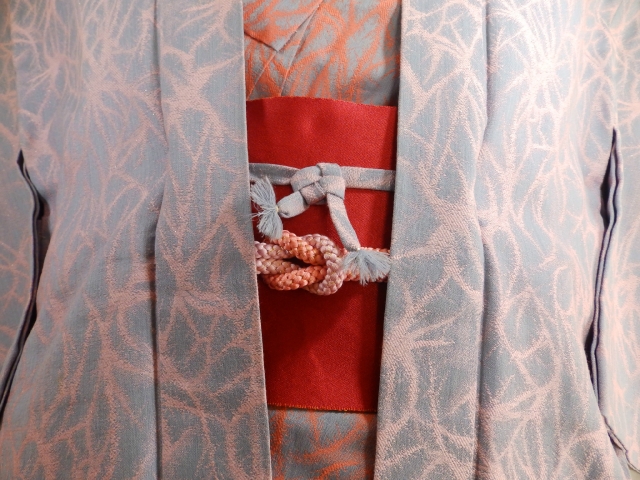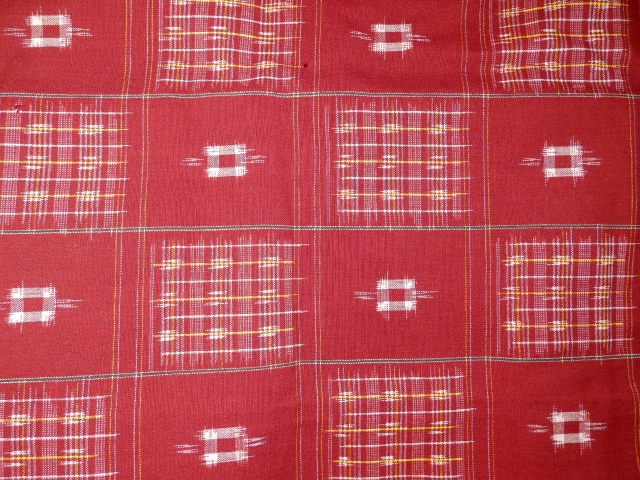Omeshi kimono is one of the weaved kimono which ranks between Komon and Tsumugi.
For men’s omeshi kimono, if it has a family crest, you can wear a tea ceremony and the formal scene.
Omeshi is made by glossy and lustrous fabric.
So it obtains incredible luxury.
Today, I’ll tell you about women’s omeshi kimono.
Contents
About Omeshi Kimono
Omeshi is shortened word of “Omeshi Tirimen” which is the most high-class weaved kimono.
It’s a waved kimono like tsumugi and cotton kimono but special omeshi yarns make grains on the surface of a cloth.
Omeshi yarns are raw silk without protein sericin.
Bunch of weft yarns is twisted, so it makes unique omeshi cloth.
Hard twist yarn fabric provides a very comfortable and smooth texture.
Famous omeshi kimono are like Nishijin omeshi produced in Nishijin district in Kyoto.
Shiozawa omeshi is in Niigata prefecture and Shirataka Omeshi is in Yamagata prefecture which is weaved by hard twist yarns.
Unlike the cloth of tirimen, omeshi kimono is weak of wetness.
The cloth might shrink, so we need to care often.
People wear omeshi kimono at the dinner party, theater, and lessons.
If it has a family crest or coordinates with high-class obi, you can wear at the fancy party.
The History of Omeshi
In the Edo period, omeshi called “Ryujou Tirimen” because 11th shogun Ienari Tokugawa loved to wear them.
From the Meiji period to Syowa period, people started to wear them apart from Iromuji.
Girls long for arrow splashed patterns which were worn by schoolgirl.
Until the war, it was very popular and everyone had them.
Dyeing kimono became standard of formal kimono.
So these days it decreased year by year.
The Types of Omeshi
Omeshi has various types of patterns and textures.
The representatives are like stripes, splashed patterns, non-patterns and so on.
Non Pattern Omeshi
This is basic texture and simple patterns omeshi.
If it has a embroidery crest, it can be a semi-formal attire with Fukuro Obi and Nagoya Obi.
Stripes Omeshi
Stripes weaved on the texture and famous shogun “Ienari Tokugawa” loved to wear them.
There are also “Daimyo Omeshi”, “Man Suji(Millions stripes)”, “Bou Jima” and “Komochi Jima”.
Splashed Patterns
This has tiny patterns on the texture.
From Taisyo period to the early Showa period, Jacquard machine developed and various splashed patterns kimono were produced.
Arrow splashed, cross and mosquito patterns are also famous.
Mon Omeshi
This patterns are weaved on the cloth.
When you move, those patterns shines .
You can wear just like Iromuji and enjoy coordinating with various Obi.
Nuidori Omeshi
Recently, we can barely see this type.
This feature is mainly used gold and silver embroidery yarns.
We can put on a family crest and it fits classy obi.
Joudai Omeshi
This texture is just like tsumugi.
Mainly using Omeshi Nuki yarns and if it has a patterns, it called “Monjoudai Omeshi”.
Tufu Omeshi
This is so high-technique texture, using completely different yarns on the front and back.
So this type can used reversible.
Summary
Women’s omeshi is loved by a connoisseur of kimono and tea masters.
Now technology changes yarns, so it rarely shrinks.
If you choose non-patterns omeshi kimono, it’ll become more moderns Kimono looks!
Please find your favorite omeshi and have fun!!










